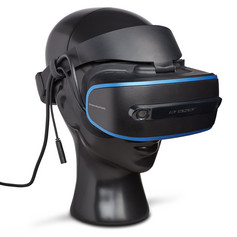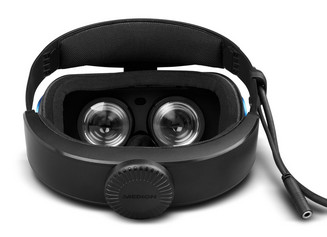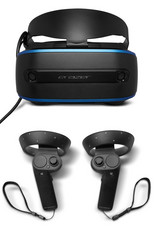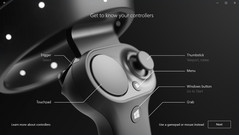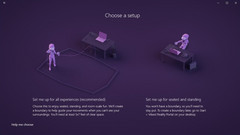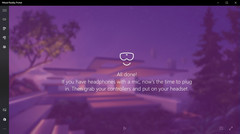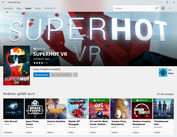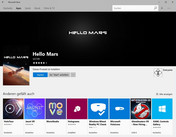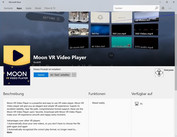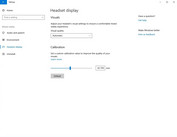Medion Erazer X1000 MR Glasses (Windows Mixed Reality) Review
For the original German review, see here.
Windows Mixed Reality is a hardware and software platform developed by Microsoft for the display of augmented and virtual content, which enables manufacturers to bring the corresponding HMDs (Head-Mounted Displays), which all fulfil certain basic criteria to the market without much development effort.
In addition to Acer, HP, Dell, and Lenovo, Medion also offers Mixed Reality glasses. With the exception of the Dell model, which is slightly more expensive but offers the same specifications in the end, the VR glasses of all these manufacturers cost 449 Euros (~$521; in the US: Acer $299 and HP $329). We are evaluating how the Microsoft concept fares in practice and whether the price is justified for the Erazer X1000 MR Glasses kindly provided to us by Medion.
Please note that we are deliberately leaving the Samsung Odyssey out of this article, since several of its specifications are different and also, it has not been released in Europe.
Accessories
Medion limits the accessories to only the bare minimum. Besides the VR glasses, the box of the X1000 headset contains only a few information sheets. However, the buyer also gets a second box with the appropriate motion controller and four AA batteries. We did not see any other accessories such as gaming codes, a cleaning cloth, or data CD.
Technology
At first glance, the Mixed Reality glasses are reminiscent of the competition from HTC and Oculus, with some differences in the detail. They begin with the headset itself, which is not only slightly lighter (particularly compared to the Vive), but also scores with a practical folding mechanism. While you need to completely take off the Vive and the Rift in order to operate the PC or notebook which is cumbersome, in the case of the Erazer X1000 and its colleagues, you simply flip up the visor.
It is fixed at the forehead via a rotary control, which is a very clever solution in our opinion, since it can be done easily while still being sturdy. Unfortunately, the hinge between the headband and the display is less sturdy. When we faced down, the visor of our test unit always loosened a few millimeters, causing plenty of light to enter inside. In general, despite the foam cushioning, the light isolation at the edge is not quite as good as in the Vive and the Rift.
Moreover, we are missing the option to adjust the distance between the display and the eyes. For someone who wears glasses, it often feels like the glasses are rubbing on the lenses of the headset. Accordingly, the glasses and lenses tend to get dirty quickly. By the way, in the Mixed Reality products the distance between the pupils is not adjusted at the HMD, but in the Windows Options, which is a somewhat unfortunate solution, since it tends to take longer (you have to first open the Desktop in the VR applications, then flip open the visor and use the PC).
Although it is basically a good thing that Mixed Reality headsets do not need a connector box such as the HTC Vive, it also increases the risk of damaging the computer (ripping out cables in the heat of the moment can damage ports). However, because of the long cables (about 4 m/13 ft) this should not happen or be extremely rare.
The Mixed Reality glasses are connected via USB 3.0 and HDMI (also DisplayPort via adapter), but for the full frequency it must be an HDMI-2.0 port. The maximum of 90 Hz is exactly the same as the specifications of the Vive and the Rift.
| Product | Medion Erazer X1000 | HTC Vive | Oculus Rift |
|---|---|---|---|
| Display | LCD | OLED | OLED |
| Resolution per eye | 1440x1440 | 1080x1200 | 1080x1200 |
| Frequency | 90 Hz | 90 Hz | 90 Hz |
| Viewing Angle | 105° | 110° | 110° |
| Weight (incl. cable) | 568 g, 1.25 lb | 883 g, 1.95 lb | 664 g, 1.46 lb |
| Connections | HDMI 2.0, USB 3.0, Audio | HDMI 1.4, USB 3.0, Audio | HDMI 1.3, USB 3.0, USB 2.0 |
| integrated headphones | no | no | yes |
| external sensors needed | no | yes | yes |
| Flip-up visor | yes | no | no |
| Price (incl. controller) | 449 Euros | 699 Euros | 449 Euros |
We see greater differences in the displays. While the competitors from HTC and Oculus trust the expensive OLED technology, the Mixed Reality glasses use only the classical LCD technology. Even though you do not notice the disadvantages of the LCD in every situation, in the long run various weaknesses become obvious. For example, dark content appears more grayish, due to the worse black value. The contrast is also worse, causing a paler overall presentation.
Added to this is that the field of view appears much smaller than in the Vive and the Rift. Although the difference on paper is only 5°, there is a much stronger porthole effect which to some extent destroys the immersion. If the lenses are not adjusted ideally, there will also be blurriness. When focusing outside, the finer elements such as writing become blurry in general, so that you might want to forget about text processing or surfing the web in VR.
Even the higher resolution can only make up for this weakness to a limited extent. Instead of 1080x1200 pixels, it is 1440x1440 pixels for each eye. Unfortunately, you will be disappointed if you think that the pixel grid typical for VR glasses will disappear with this. You can also see a grid of horizontal and vertical lines in the Mixed Reality models, which also impacts the immersion. The same goes for the sub-pixels, which are visible. We also did not like the lack of built-in headphones. Since it is easy to forget external headsets, they are likely to drop on the floor when taking off the VR glasses, particularly since there are additional cables and more weight.
On the other hand, Microsoft deserves some praise for the internal tracking of the HMDs via cameras. While you need external sensors which track the movement in space for the HTC Vive and the Oculus Rift, Mixed Reality works without those boxes, which only take up space and make the transport of the whole VR system and its setup on location more difficult.
The solution for the tracking of the controllers is not as good and comfortable to hold as those for the HTC Vive and others. Since the controllers depend on the field of view of the HMD cameras, contact during expansive hand movements often gets lost. The problem is that the controllers are not always recognized reliably when they go back into the field of view and then remain hanging somewhere in the (virtual) air or wiggle around somewhere. Accordingly, you should be careful to avoid performing some acrobatic tricks during gaming.
Microsoft could also improve on the communications. Instead of transferring data directly from the VR glasses, the Mixed Reality solutions communicate with the computer via Bluetooth 4.0. While any reasonably current notebook supports Bluetooth 4.0, this technology is rare in tower PCs due to the missing communication module, so that you need additional hardware again. It is also annoying that you cannot charge the controller batteries via a USB cable. Even though the included AA batteries lasted for two days, this is not really environmentally friendly.
| Requirements | Minimum | Recommended |
|---|---|---|
| Operating System | Windows 10 incl. Creators Update | Windows 10 incl. Creators Update |
| Processor | Intel Core i5-7200U | Intel Core i5-4590 or AMD Ryzen 5 1400 |
| Graphics Card | Intel HD Graphics 620 | Nvidia GeForce GTX 960/965M/1050 or AMD RX 460/560 |
| Working Memory | 8 GB DDR3 | 8 GB DDR3 |
| Storage | 10 GB of usable space | 10 GB of usable space |
| Connections | 1x USB 3.0, 1x HDMI 1.4 or DisplayPort 1.2, Bluetooth 4.0 | 1x USB 3.0, 1x HDMI 2.0 or DisplayPort 1.2, Bluetooth 4.0 |
The moderate requirements for the system received some positive points. While the HTC Vive and the Oculus Rift need more or less a high-end PC, theoretically an office notebook with an energy-efficient CPU and integrated graphics unit would be sufficient for the Mixed Reality headsets (see table). Anyone who would like to play games other than the less demanding tasks such as VR videos should at least have a mid-range computer. Microsoft recommends a GeForce GTX 960, GTX 965M or GTX 1050 by Nvidia, or a Radeon RX 460 or RX 560 by AMD for graphics cards,.
Furthermore, you need at least 8 GB of DDR3-RAM and 10 GB of available storage on the hard drive. And without Windows 10 including the Creators Update, it will not work. We ran our tests on an Alienware 17 R4 with Core i7-7820HK, GeForce GTX 1080, and 32 GB of DDR4-RAM, so it was a real gaming system.
Installation and Setup
While the setup and installation of the HTC Vive and Oculus Rift are not rocket science, Mixed Reality impresses with its much faster and more comfortable setup process. Once you connect the VR glasses via USB and HDMI to the computer, a Welcome screen which will guide you in a few steps through the installation process will pop up after a few seconds.
After a brief system test where the computer is tested for the necessary hardware and software, it needs to download just 2 GB of files from the internet. After that, it starts immediately with the explanation and the setup of the controllers, which have a small key for the Bluetooth pairing in their battery compartment. These need to be pressed for several seconds after the activation via Windows key.
If everything has worked out, the software wants to know whether you want to use the VR glasses only while seated or also while standing up or in a user-defined space. Of course we recommend the latter for the complete VR pleasure. To set the boundaries optimally – surprise, surprise - the desired area should be free from any objects (tables, chairs, etc.). You set the boundaries of the space by walking around the edges with the VR camera in front of your chest (in the HTC Vive you use the controller for this).
We are not familiar with the Mixed Reality technology in its current state. Probably some fixed points are taken as the reference, which can lead to Mixed Reality not being able to recognize the saved space. This happened several times during the test, but usually a restart of the VR software resolved the problem. Mixed Reality also had some problems in poor light conditions. It hardly worked for us to play games in the dark - if at all.
Now back to the setup: once the whole process which only takes a few minutes to complete, and you put on the VR glasses for the first time, Mixed Reality throws the user into the so-called Cliff House, a central place to go, which can hardly be customized visually, but whose walls can be plastered with various programs (Media Player, chat, web browser, games, etc.). This is very practical and enables a complete VR hub.
Applications
One of the biggest drawbacks of VR continues to be the relatively meager supply of software. While the HTC Vive can at least use the rapidly growing supply of Steam, the Mixed Reality products were limited to the Microsoft Store, whose VR portfolio turns out to be extremely meager.
There is a short space exploration (Hello Mars) and a nice short film (The Rose and I), but even the free apps are limited. Intensive VR fun for several weeks, months, or years is definitely not available. Without the excellent Superhot VR, which was specifically developed for Virtual Reality but costs 25 Euros (~$29), we would have been bored on the first day.
Superhot VR is impressive and shows what Virtual Reality can do and how a game should be designed for it. When you duck virtual bullets or fists in real space and throw things at your enemy at the same time or take your gun or your own hands, there is such a strong sense of immersion that you ask yourself how you could have done without VR in the past and when it will finally be successful in the mass market.
With VR a level of credibility and realism unknown until now is reached, which revives old debates such as that about violent games. If the characters of Superhot had not been stylized by red crystal forms, the author would really hesitate to kill or shoot an opponent, which again speaks for the quality of VR.
But Superhot or not, in terms of VR, the Windows Store is a sad story. Fortunately, the preview for Valve's Steam VR was announced for November, which would solve the problem. Whether free or paid for game titles, Steam has a much larger and better VR database.
A little hint for users who want to enjoy VR videos from the internet or the hard drive: you need a specific program for VR capable movies, which you can recognize by the double logo on the top/bottom (360°) and left/right (180°). For Steam, the Virtual Desktop tool is recommended, and in the MS Store, we found the Moon VR Video Player, which however, crashed from time to time.
Speaking of crashing: at this point Mixed Reality is not fully mature yet. We saw everything from black screens and faulty camera positions in games to crashing apps, which might of course be the fault of the software developers. We encountered fewer dropouts using the combination of HTC Vive and Steam VR.
Verdict
Taking all the aspects together, the Oculus Rift, the HTC Vive, and the VR glasses based on Microsoft's Mixed Reality play at about the same level. Even though there are greater hardware differences in the detail, the resulting overall experience is comparable. Whether you prefer the Microsoft solution, which scores particularly with comfort (setup, installation, weight, etc.), or the systems by the competitors, which enable a better image and more exact and reliable operation thanks to OLED display and external tracking, even in 2017 you should still think twice about buying VR glasses.
In our opinion, even the Mixed Reality headsets are too heavy and uncomfortable in the long run, not to mention the limited field of view and the noticeable pixel grid (incl. sub-pixels), which should only disappear or be too small to interfere from a resolution of 2160p per eye. The limited software offerings are also likely to scare off many interested buyers. After all, almost 450 Euros (~$521) for the Mixed Reality package, i.e., HMD and controller, is a lot of money, which has to be balanced against entertainment. Personally, the author would wait to purchase VR glasses of the next generation when they are hopefully more affordable, lighter and more compact, and have a sharper resolution.
Despite the 3D experience which is already impressive, currently Virtual Reality still is and remains a relatively expensive toy for enthusiasts and techno fans.





